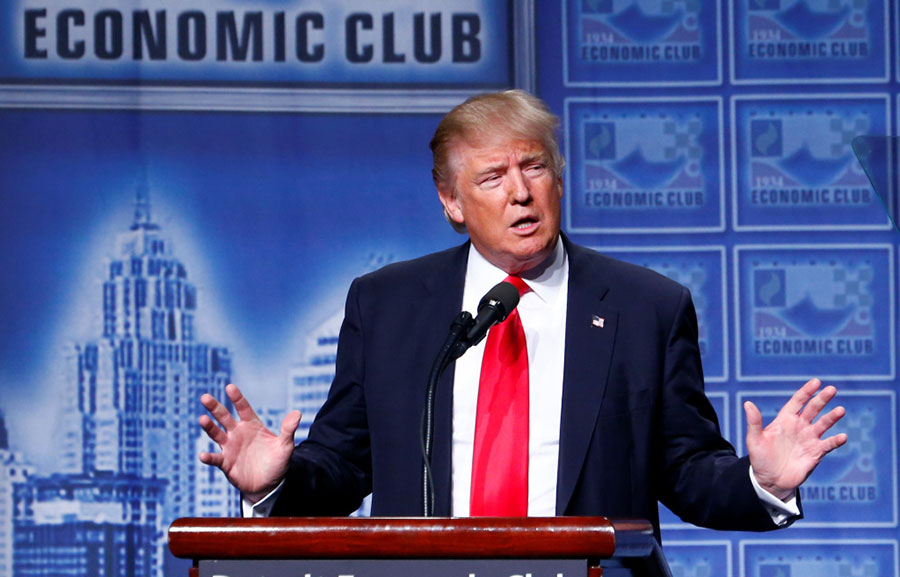Republican presidential nominee Donald Trump delivered a speech to the Detroit Economic Club, clarifying how he intends to revive the US economy.
It seems that what most picked up are a series of doubts that, although do not disprove Trump’s plans for the economy, show that there is a lack of global perspective on the areas of taxes and financial regulations. Trump’s plan, named ‘An America First Economic Plan: Winning The Global Competition’, proposes lower taxes, lesser regulations for businesses, eliminating anti-energy regulations, and dissolving the Trans-Pacific Partnership (TPP).

A focus on creating jobs and reducing internationalization
The primary focus of Donald Trump campaign on economy lies in providing Americans with jobs, reducing external manufacture and energy regulations, and cutting off business ties, especially in China. According to the GOP candidate, 50,000 jobs have been eliminated from Michigan due to the efforts of relinquishing coal-fired power plants.
“The Obama-Clinton Administration has blocked and destroyed millions of jobs through their anti-energy regulations while raising the price of electricity for both families and businesses,” Trump stated in his speech.
Trump highlighted Obama and Clinton’s intentions on restricting oil and natural gas production, arguing that it costs tens of millions of jobs. If left unchanged, current energy restrictions would cut off $2.5 trillion from the economy over the next 15 years.
What Trump suggests is to put restraints on external entities performing business in the US, while lifting restrictions on local enterprises and sources of energy. Trump says that his plan of rebuking the current restrictions on energy will add over $100 billion to the GDP, alongside 500,000 new jobs and higher annual wages. Also, tax revenues would increase by around $6 trillion over the next forty years.
Trump also remains strong on tariffs on imported goods to promote local labor. It would also lead consumers towards buying more American products, but on the other hand, it would mean that significant importers such as China and Mexico would also place tariffs on American-made goods. Clinton referred to Trump’s intentions on isolating certain parts of the economy as attempts at starting a trade war, which would harm the United States’ position as a global market leader.
Although Trump’s points are valid, he is basing his plan on attacking existing measures, rather than promoting new ones that are can build upon what the past presidential term has achieved. Even if many complain that the Obama administration has not been effective, there is a consensus that the United States is better now than when Barack Obama took office eight years ago, specifically when it comes to leadership, jobs, and its position as a global power.
The nominee’s take on taxes
In contrast to Trump’s stance on economics, Hillary Clinton aims toward increasing taxes for the wealthy, while putting more funds toward forming job capacity and benefiting companies that hire more American citizens. The extra tax income, coming from an additional 4 percent for people who earn more than $5 million a year, would be used for promoting free college education for families without sufficient resources.
In short, according to the Tax Policy Center, if Trump were to win the presidency, his plan on the economy would reduce government tax income by $9 trillion in ten years. For Clinton, it would add $1.1 trillion. The Democratic candidate will be presenting her speech addressing the economy next Thursday.
Trump will impose tax rates of 12, 25, and 33 percent, contrary to the previous 10, 20, and 25. Even if it is a better plan than what he had before, it is estimated that it would increase the US’ debt significantly. Clinton, on the other hand, pretends to keep taxes pretty much the same, except for wealthy individuals.
“We urge Donald Trump to put forward a tax framework that will cost as little as possible […] of new spending cuts and entitlement reforms that would not only pay for any remaining tax cuts but also put the national debt on a downward path relative to the economy,” stated Maya MacGuineas, president of the Committee for a Responsible Federal Budget referring to Trump’s recent speech on economy.
The Committee for a Responsible Federal Budget responded to Trump’s claims that the US is one of the highest-taxed countries. They argued that that the average tax in any country corresponds to 34 percent of the GDP, while the US charges only 26 percent, setting itself behind Australia, Japan, Canada, Italy, France, and many others.
But both candidates agree that the Trans-Pacific Partnership has to be either revised (Clinton) or dissolved (Trump). It is a plan where 12 countries located in the Pacific Rim agreed to become economic allies, reducing trade barriers such as import tariffs and regulations, which would translate to almost half of the world’s economy. When it was first proposed, Clinton supported it, but it now seems that she has changed her mind, as the TPP means losing millions of lost jobs. It is estimated that, only through the TPP, the US lets go over 100,000 jobs to Vietnam, a country whose minimum wage is 56 cents an hour.
Over 500 American companies operate through the TPP, and they would much rather have cheap labor rather than supporting the national economy, which is one of Trump’s main points of leverage. Voters will have to wait until Clinton’s proposal to weigh each candidates’ views on strengthening the national economy, primarily by restraining outsourcing and imports.
Source: Bloomberg
